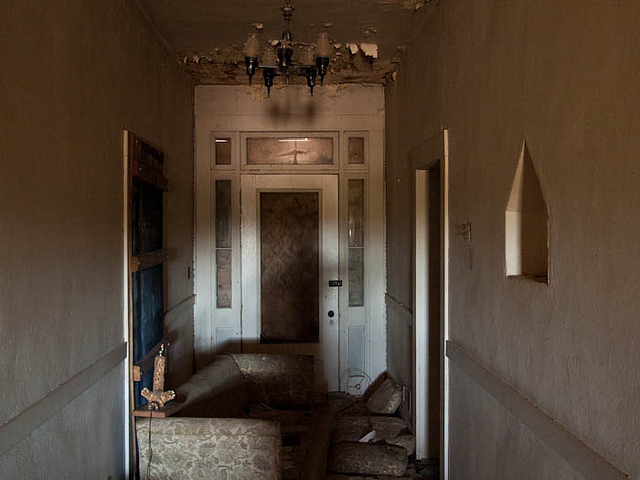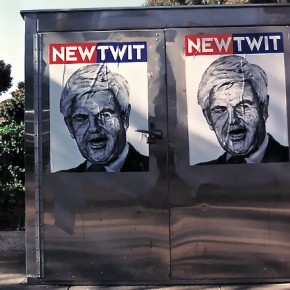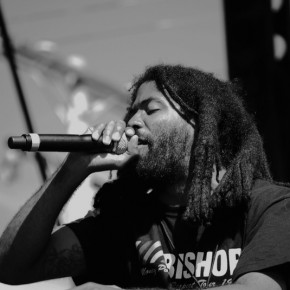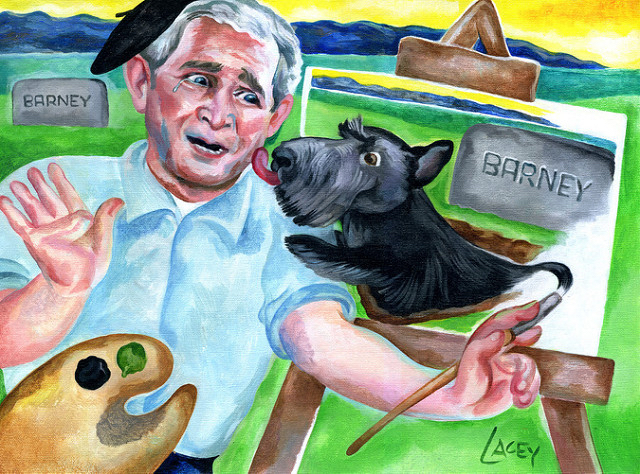You never know what you’re going to find when you shoot photos in the dark. The little cluster of houses is visible from Interstate 10. They look like they’ve been abandoned for decades. Their collapsing roofs blend with the scrub and dirt of the desert, and the place looks like it’s completely outside of time. Like they’re something from the Wild West before it was paved over for big box stores and before the freeway traffic flew by at 80 mph, too fast for people to notice this little patch of desolation. These houses have been still for a long time. Their only movement is the slow collapse of their structures as nature takes over and the buildings slowly disintegrate and become just another part of the bleak desert landscape.
It was a perfect day for my partner Mark Hahn and I – we’re collaborating on the Copper Belt Project together – to find our way to the complex of houses and discover what we could capture with our cameras. The winter light was beautiful as we drove up I-10. It didn’t take us long to get to the Avra Valley Road exit, where we spotted the ramshackle houses just north of a power plant, clustered behind fields of some dead-looking crop. We could see the houses, but we couldn’t reach them. The frontage road next to the railroad tracks didn’t seem to provide access.
We decided to head back to the freeway to look for a different way in. There was a bad car crash on the shoulder of the highway. One vehicle was turned upside down. A girl sat next to the side of the freeway cradling her head. People were running up the shoulder of the highway waving cell phones. Gusts of wind blew dust in apocalyptic clouds. The roof of the girl’s car was completely caved in.
“I don’t want to look,” I said. We got off the freeway again, this time at the brand-new Twin Peaks interchange. But all we found were more railroad tracks and the frontage road. We passed a row of closed shops, a cement factory, a rental facility where you could get things like jackhammers and forklifts. The businesses on the frontage road have given way to the big box complex a couple of miles up the freeway, where Walmart reigns supreme. The old local markets that sell everything from milk to Budweiser to motor oil are on their way to extinction.
We crossed the freeway and found a new stretch of road. Its smooth freshly paved surface cut east like the gateway to 21st century hell. The road that appeared to have once led to the complex of houses had been bulldozed. A giant mound of dirt and rubble blocked entry. The sides of the road were adorned with tacky Southwest themed metal decorations. On this stretch of road, the “real” desert had been paved over and replaced with a stereotyped image out of a magazine.
The abandoned houses by the fields couldn’t be reached. They were cut off entirely from the rest of civilization, which at this point consisted of outer Marana and its endless sprawl of new housing developments full of empty houses with foreclosure signs adorning their gravel yards.
We got back on the frontage road and decided to park by the railroad tracks and walk across the dead fields to the houses. Somewhere up the road, a girl was cradling her head. Cables and cords from old tube computer monitors lay like dead snakes in the dry dirt. Cars zoomed on the interstate overhead. People were going about their business of speeding from here to there, while just east of the freeway a group of houses from another time stood unnoticed, disintegrating.
We began our walk with cameras and tripods in tow. The railroad wound its way across the landscape. The power plant hovered in the distance like some kind of transmission station emitting signals from the vast desert. We were pushing our way through the wind when we saw the police car pull off the freeway and park alongside my car.
He stepped out of his cruiser and started walking toward us. “What are you doing out here?” he asked us. We told him we were photographers shooting photos. We pointed to our cameras and tripods. “I got a call reporting a man with bolt cutters,” the cop said. He was using his “official” cop voice to let us know he meant serious business. I laughed. “Bolt cutters!” Mark and I held up our tripods. “We have tripods!” The cop still had his serious face on and asked for our IDs. I said, “We were just taking photos of the railroad tracks.” The cop gave me a scrutinizing look. That’s when I turned on my camera and showed him the photos. “Look,” I said. “Here we are walking on the railroad tracks.”
The cop looked at the screen on the back of the camera and actually smiled. I figured this was a perfect opportunity to get a green light to cross the fields to those houses. I asked him, “We were going to walk out here and take photos. Is that okay?”
The cop looked around. “Just stay off the railroad tracks. They’re private property. Other than that, I don’t see any ‘No Trespassing’ signs, so go ahead.” Then he kidded, “Just watch out for farmers who might want to shoot you for their sorghum.” That’s how I found out that the fields were sorghum fields. Before the cop told us that, I just figured they were fields of weird dead looking orange stuff. With the cop’s “free pass,” we were on our way to find the complex of abandoned houses.
We began our walk on the dirt path past the power plant. The buildings at the power plant were austere and beautiful in their empty minimalism. The existential geometry and industrial colors had an aesthetic appeal. It was as if any human spirit was intentionally erased from these basic architectural forms with their complete absence of decay and human imprint. We paused at a bend in the road, set up our tripods, and snapped a couple of shots aimed at a porta-potty and a large tank. The dilapidated fencing of a large collapsing house peeked out from behind the trees. The air was agitated with tension between the buzz of the power plant and the aura of decay from the abandoned houses. The power plant’s silent energy coursed its way through its towers and wires while the desolate buildings just around the corner emitted their own kind of quiet force.
We pushed our way through the scrub to a dirt road that led to the houses. We climbed over the fallen barbed wire fence and stared at the massive site of dilapidation. It was so vast in its emptiness and decay. Wind rattled loose boards. We walked around the building trying to take it all in, but it was so overwhelming we needed to just let the place seep into us so we could see what it wanted to show us. Sometimes, we have to let the place speak before we can lift our cameras.
The place was an old ranch house of some kind. It was the decaying remnants from the pre-suburban landscape, the one famous from Hollywood movies. Wood fencing had fallen to the ground. The ladder to an old water tower lay on the dirt. But the place was dry as a bone. Metal gates clanked against rotting fence posts. Dead trees lay all around the place like the bodies of fallen giants. This was truly a “ghost house” of the Old West.
Although it seemed dead, the whole place was haunted with an eerie presence. Even in the vast waste of dirt, there was evidence of the the lives that passed through it. Doors to old stables flapped open on broken hinges. The horses are all gone now. Inside one stable, a rope hung from the rafters. I grabbed it. I knew it probably served some kind of utility purpose, but I couldn’t help but think “noose.” I felt like I was caught somewhere between the Westerns of John Ford and a Rob Zombie movie. There are so many myths of the old West, and they all seemed to coalesce in this empty ranch.
Empty water bottles were piled in every corner on the back porch and in the stables. They were remnants of another kind of phantom – illegal aliens and drug runners crossing the desert from Mexico. With the train tracks right across the field and the border spitting distance away, this ghost house was now a major hideout for people who don’t want to be seen. We expected to stumble upon a group of border crossers at any moment.
The place was so desolate and empty, but at the same time, the emptiness pounded at us in a cacophony of silence. The psychic load of the history of the place coupled with the fact that it was clearly a dangerous to be made the landscape overwhelming. We stood in the wind and took it all in and wondered where to begin.
Winding our way through the scrub to the buildings behind the big house, we came upon a cluster of smaller houses. Cars stood on blocks, their flat tires sinking into the desert floor. Windows were knocked out of one house, but another still had the windows intact. A small red trailer was parked at the side. We couldn’t tell if the houses were abandoned or occupied. We were in that nebulous region between the ghosts of the past and the living threats of the present. A glint of shiny metal from a newish truck caught our eye from the side of one of the houses. We felt eyes watching us.
We shot the orange car because the orange car seemed significant. At one point, this car had represented someone’s dream. It was the car that was supposed to take people out of here, take them to places that wouldn’t dead end at a cluster of houses falling apart in the middle of the desert. The car was supposed to be a ticket out, not a coffin sinking slowly into the dirt in a place where the road has been cut off and replaced with newer roads for newer houses with newer cars. The orange car stood like a totem for all the dead dreams trapped in this dead place.
I walked closer to the car but then stopped. Suddenly it felt like all the windows of the houses had eyes. If someone saw us walking through the brush, they might mistake us for “illegals,” and people wouldn’t think twice about taking a shot at us. This was Arizona, after all, a state where guns and vigilantism are a way of life. In this state full of racists and minutemen, we could be shot at and left for dead just like the orange car. We headed back to the big main house.
We pulled on the front door and it swung open. Whoever had left the house last had left it unlocked. The hallway was steeped in shadow. An old chandelier hung from the ceiling and piles of stuff lined the walls – an ironing board with a roll of Christmas wrapping paper sitting on top of it, bicycle tires, rolls of ribbon, books, stacks of papers and envelopes. Darkness seeped out of the doorways that lined the halls. The place was so dark, and the dark was pushing down with a suffocating weight.
We set up our tripods, but it was clear that we were not the ones determining what would turn up inside our cameras. We were going to be shooting in the dark, and it was up to the house to tell us what it wanted us to see. As I moved through the house shooting photos, I felt like I was just a vehicle through which the house was speaking. It was so dark that the exposures had to be very long. I pressed the shutter release and waited for the camera to process the image. That space between clicking the shutter and waiting for the image to burn itself into the memory card was like some kind of line of extrasensory communication. I had little control over the images that would materialize. I was shooting ghosts.
I tried to control the images by increasing the exposure, but that only converted the rooms into something else. It stripped the darkness out of the place and provided an illusion of light that was really just a kind of dirty flatness. It is hard to convert dark to light, and it is even harder to accept light when I know there is only dark. This place was dark. And it wasn’t just the lack of light that was dark. It was the emotional weight of the place.
I walked into the front bedroom and found a piano pushed up against the collapsing bed, the keys barely discernible in the dark. Clothes hung tidily on hangers in the closet, yet the hulking body of the piano had been pushed so close to the bed that it was forcing the bed to collapse in on itself. I imagined the strength and heft it took to move that piano, how the same hands that shoved the piano into the bed hung the suit jackets in the closet. The room was suffocating in stillness. The piano cranked out silent remnants of hymns played on Sunday evenings.
I looked through the viewfinder in my camera to try to capture this room, but all I could see was a black rectangle with no evidence of the piano or the bed. I cranked the exposure, aimed the tripod and shot. The camera did its job. It performed a mechanical capture of the evidence within the room – a dresser in the corner, the collapsing mattress, a taped and boarded window. But the camera is a mechanical device, and nothing about this place could be reduced to mechanics. This was an emotional landscape of loss, death, abandonment. It was impossible capture my personal perception and emotional response to this room. The camera grabbed what light sources it could to illuminate the objects in the room, but the end result was light without light. The luminosity was gone, and the light fell flat and dirty. I realize now that is what the house had to say: the light was gone.
Inside the kitchen, light from outside pushed its way through the door in smudges. Baking pans were piled next to the kitchen sink, but the claustrophobic sense of stasis, abandonment and darkness persisted. Kitchens are the central “hub” of domesticity in a house. The kitchen is where traces of family gatherings linger, where meals were prepared and eaten, where people came together as a family. Abandoned kitchens are the ultimate symbol of the collapsed home, of domesticity gone to the trash heap.
While evidence like baking dishes, teapots, glassware and pot holders can point to happier times (birthday parties, Thanksgiving dinners, Saturday morning breakfasts, coffee over cards), the disheveled state of abandon is unsettling, as if life had one day got turned upside down and stopped. Cleaning supplies coughed out of the cabinet under the sink as if the place was trying to clean itself. Instead it just made a big mess to add to the psychic mess that permeated this house.
How could all the clothes in the closet be hanging so neatly, yet the cabinets of the kitchen be emptied with such disregard? These walls could be emptied of every single remaining item from the people who occupied it, but somehow it would never be empty.
A bookshelf in the hallway was stacked with National Geographic magazines. I pulled the magazines off the shelf and looked at the dates. July 1961. May 1965. June 1972. They stopped in 1981. For a brief moment, I wanted to take the magazines and make a collage out of them, construct a piece of art from the remnants of this old collapsing house. I thought somehow that the fact that they came from the house would be translated into the collage object. Then I realized that not only would the physical weight of the magazines be impossible to carry across those sorghum fields, but the psychic weight would be unbearable. I would be stealing from ghosts. I would be bringing them home with me. I put the magazine I was holding back on the shelf and straightened out the stacks.
Then I walked into the back bedroom and was sucked into more darkness. Blinds collapsed like broken ladders from the boarded up window. A dead TV sat on a small table. It had nothing left to broadcast except a dull screen covered with a layer of dust. A curtain hung like the dirty hem of a ballroom dress. I stood as if I were standing inside a very dark dream that was closing in fast. The bedroom was pitch black with just a faint glow seeping through the boarded up windows. I aimed my camera and shot. The shutter took an eternity to close. It was so dark.
But what when it was finished, I discovered the heartbeat of the house inside my camera. Little slivers of light leaked through cracks in the roof just enough to illuminate the ominous body of the bed, the broken blinds, the curtain draped in stillness, and the dark vacuum of the room. The photo was completely still, yet agitated with the psychic detritus of the people who once slept on that bed and collected all those papers. Taking that photo, I realized that sometimes the only way to see what matters is to look into complete darkness.
At this point, what little light remained in the house was disappearing fast. It was impossible to see my own hand in front of my face. On the way out the door, I looked down at a couple of bicycle tires frozen in time. The bike was nowhere to be found. These tires stood like amputated limbs removed from their body. They weren’t going anywhere. Nothing in this house was ever going anywhere.
We left the house and carefully closed the door and fastened the hook inside the screen door. The sun had sunk behind the mountains, and the sky had darkened with our moods. Some places are like that. They are layered in darkness. They carry a heavy psychic burden. The lingering ghosts of those who occupied the houses can merge with the lingering ghosts of our own lives. The places are containers for emotions we can’t name, so we assign them to architecture instead. They spill out of kitchen cabinets and lie in heaps on collapsing mattresses in dark bedroom. When we stepped back outside, we were carrying the burden of the ghosts of the house and of our own ghosts.
As we headed back toward the dirt path, I realized that my camera bag was missing. I ran back into the house in a panic looking for it. I unhooked the latch and stepped inside. Now, all the light had been sucked out of the rooms. I looked into the bedrooms and couldn’t see a thing. They were completely engulfed in darkness. If my camera bag was there, it was mixed in with the piles of boxes, clothes and collapsing furniture. Maybe it was hanging inside the closet. The darkness was choking me. I ran back outside and left the door flapping open behind me. My camera bag was sitting on the ground by my tripod.
“Let’s get out of here,” I said. We found our way back to the dirt path by the sorghum fields and walked back to the car overwhelmed by a sense of heavy melancholy. We made it back to the car and got back on the Interstate. We were once again part of the world of the living traveling at 75 mph. We were no longer frozen in time in the middle of the desert. The girl holding her head was gone, and there were no signs that a terrible accident ever happened. The houses across the fields bled into dusk and were lost. Cars on the freeway were outrunning the place where time stands still. I stepped on the accelerator and drove a little faster.
Later, when I looked at my photos, I was disappointed. My camera was on the wrong settings for most of the shots, so they were all distorted with noise. I didn’t like how the only way to capture the dark rooms was to erase the darkness. Everything looked dirty, dingy, flat and lifeless. Now I’m thinking maybe that’s the point. This place is lifeless, and the only life inside it comes from our own emotional responses, like distorted transmissions we project onto the place. It is impossible for images not to be distorted when they are filtered through a thick layer of psychic debris and our own complex emotional responses to a place. It’s hard to control the emotional landscape of a place, especially when you’re shooting into darkness. Sometimes you just have to let the place say what it needs to say.
As I studied the photos, I felt possessed by the place. I was overwhelmed with the need to go back, as if I had missed something really important, as if it still had something else to say to me. As we were leaving, we had discovered a boarded-up window to a room we didn’t go inside. Looking at the photos of the hallway we realized that room is boarded up from the inside, and it has a sofa pushed in front of it to block access. As I write these words, I know that house is right over the mountains from where I am sitting and typing. I feel the house pulling at me, to go back inside, pull that sofa away from the door and find what is secreted away in the darkness.
I have tried to find out more about the house, but all I have found is where it is on google maps, a dirt road that will take me there. A newspaper I found in the kitchen was dated July 2000. That doesn’t seem so long ago, only eleven years. Yet, this is a place where history stopped. It seems like it’s always been abandoned, that it exists as a repository for all that is lost and forsaken, as a holder for things that aren’t supposed to be found. Yet from the minute I found the dirt road leading to the house, I have felt compelled to go back.
I haven’t gone back, though. Out of all the places Mark and I have visited together, this place is probably the most dangerous. Its proximity to the freeway, the railroad tracks and the Tucson and Phoenix metropolitan areas make it risky in a different way than the more remote locations we shoot for our Copper Belt Project. It may seem frozen in time, but time is moving forward quite rapidly just up the road, and it is often moving with guns and ill intentions. Drug runners. Minutemen. Angry men with bones to pick. These are commonplace in this landscape.
But still, when I ran out of the house, I forgot to latch the door. I hate to think of someone getting in from outside or something from inside getting out. Maybe I left the door open because I need to go back into the dark and find what is waiting there for me. Maybe I need to step inside and shoot in the dark, so I can finally see the thing that is missing, the thing I need to find, to hear what the house is telling me. Then again, that’s probably the last place on earth I should go right now.



















